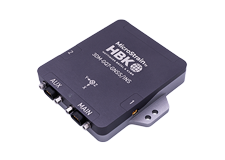Inertia-Link® is a high-performance Inertial Measurement Unit and Vertical Gyro utilizing miniature MEMS sensor technology. It combines a triaxial accelerometer, triaxial gyro, temperature sensors, and an on-board processor running a sophisticated sensor fusion algorithm.
Inertia-Link® offers a range of output data quantities from fully calibrated inertial measurements (acceleration & angular rate or deltaAngle & deltaVelocity vectors) to computed orientation estimates (pitch & roll or rotation matrix). All quantities are fully temperature compensated and corrected for sensor misalignment. The angular rate quantities are further corrected for G-sensitivity and scale factor non-linearity to third order.
Inertia-Link's communications interface hardware is contained in a separable module, and can therefore be easily customized. Currently available interface modules include USB 2.0, RS232 and RS422. An OEM version is available without the communications interface enabling the sensor to be integrated directly into a host system's circuitboard, providing a very compact sensing solution.
The 3DM-GX2® Software Development Kit (SDK) provides application builders with robust protocols and source code samples to operate the Inertia-Link® and 3DM-GX2® orientation sensors. The SDK includes a complete Data Communications Protocol manual, a detailed Users manual, ANSI C Implementation and API. Sample applications demonstrating many protocol commands are provided with fully-commented source code for Microsoft® Visual Studio C++ 2003/2008 Express, LabVIEW® 7.1.1, Microsoft® Visual Studio Visual Basic 2005 and Microsoft® Visual Basic 6.0.
Product no longer stocked – limited availability
Contact for pricing and lead time--a minimum order quantity may apply
Datasheet Manual- small, light-weight, low-power design ideal for size-sensitive applications including wearable devices
- fully temperature compensated over entire operational range
- calibrated for sensor misalignment, gyro G-sensitivity, and gyro scale factor non-linearity
- simultaneous sampling for improved time integration performance
- available with wireless and USB communication interfaces
- user adjustable data rate (1 to 250Hz) and sensor bandwith (1 to 100Hz)
- outputs include Euler angles, rotation matrix, deltaAngle & deltaVelocity, acceleration and angular rate vectors
| Orientation Range (pitch, roll, yaw) | 360˚ about all axes |
| Accelerometer range | +/- 5 g standard +/- 1.7 g and +/- 18 g also available (+/- 18 g may require export license) |
| Accelerometer bias stability | ± 0.010 g for ± 18 g range ± 0.005 g for ± 5 g range ± 0.003 g for ± 1.7 g range |
| Accelerometer nonlinearity | 0.2% |
| Gyro range | Gyros: ± 300°/sec standard, ± 1200°/sec, ± 600°/ sec, ± 50°/sec also available |
| Gyro bias stability | ± 0.2˚/sec for ± 300˚/sec |
| RF Output Power | 0dBm (1 mW) |
| Gyro nonlinearity | 0.2% |
| A/D resolution | 16 bits |
| Orientation Accuracy | ± 0.5˚ typical for static test conditions ± 2.0˚ typical for dynamic (cyclic) test conditions and for arbitrary orientation angles |
| Orientation Resolution | <0.1˚ minimum |
| Repeatability | 0.20˚ |
| Output modes | Acceleration and angular rate, deltaAngle and deltaVelocity, Euler angles, rotation matrix |
| Interface options | RS232, RS422, USB 2.0 and wireless - 2.45 GHz IEEE 802.15.4 direct sequence spread spectrum, license free worldwide (2.450 to 2.490 GHz) - 16 channels |
| Wireless communication range | 70 m |
| Digital output rates | Standard RS-232, USB or RS-422 interface: Up to 237Hz Wireless interface: Up to 100Hz OEM or custom interface: Up to 1000Hz |
| Serial data rate | 115200 bps |
| Supply voltage | +4.5 to +16 volts DC |
| Power consumption | 90 mA |
| Connectors | micro DB9 |
| Operating temperature | -40 to +70˚C with enclosure -40 to +85˚C without enclosure |
| Dimensions | 41 mm x 63 mm x 24 mm with enclosure 32 mm x 36 mm x 15 mm without enclosure |
| Weight | 39 grams with enclosure, 16 grams without enclosure |
| Shock limit | 1000 g (unpowered), 500 g (powered) |
*Accuracy and stability specifications obtained over operating temperatures of -40 to 70˚C with known sine and step inputs, including angular rates of ± 300˚ per second.
Patents pending.
This product is now a legacy product.
No, not currently. If you need an analog out option, please consider our 3DM-GX1® at:
Yes. We provide a complete data communications protocol manual which describes in detail each and every command and response that is available with the devices. Applications may be developed in any programming environment (C, VB, LabVIEW, Matlab, etc.) which supports communication via serial port.











